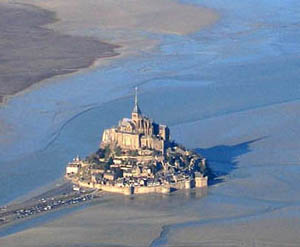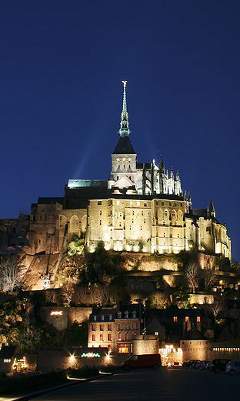About-France.com
- the connoisseur's guide to France
COVID info:
France is fully open for tourism
- Explore France ►
- Essential pages
- Travel in France
- Where to go
- What to see and do
Mont Saint-Michel - World heritage site
Location:
Northwest France, near Avranches - Department: Manche (50)
Region: In Normandy, but right on the border with Brittany.
Distance from Paris: 358 km by road .
Nearest cities: Caen 126 km Saint Malo 60 km Rennes: 91 km
Nearest railway station: Pontorson, on the line Caen-Rennes. There are buses from Pontorson station to Mont Saint Michel.
Other access from Paris: TGV train to Rennes, then connecting bus service. Click here for more details.
Tickets: Priority entrance tickets available online ► click here .
Region: In Normandy, but right on the border with Brittany.
Distance from Paris: 358 km by road .
Nearest cities: Caen 126 km Saint Malo 60 km Rennes: 91 km
Nearest railway station: Pontorson, on the line Caen-Rennes. There are buses from Pontorson station to Mont Saint Michel.
Other access from Paris: TGV train to Rennes, then connecting bus service. Click here for more details.
Tickets: Priority entrance tickets available online ► click here .
For Hotels
near Mont-Saint-Michel: click hotels
For holiday cottages
near Mont Saint Michel click cottages
in Normandy
Accommodation at Mont Saint Michel or nearby
Holiday gites
Check out a choice of cottages and gites in Normandy
Check out a choice of cottages and gites in Normandy
Hotels near Mont-Saint-Michel
Click here for a choice of hotels in the vicinity of Mont Saint Michel
This remarkable medieval walled city, crowned by its great gothic abbey, is built on a small granite outcrop standing all by itself in the flats of the estuary of the river Couesnon, in an area now known as Mont Saint Michel bay. Mont Saint Michel was one of the first monuments to be classed as a UNESCO world heritage site, as far back as 1979.
 Le Mont Saint Michel is not just a church on a rock; it is a whole
medieval city, one of the few places in France to have
preserved
intact its medieval walls and defences. The city, though small, has to
this day inhabitants - not many full time inhabitants - and a mayor,
and in addition to its religious monuments, has old houses, narrow
streets, hotels, restaurants and shops, all catering for the
over-a-million tourists who come to visit this magnificent site each
year.
Le Mont Saint Michel is not just a church on a rock; it is a whole
medieval city, one of the few places in France to have
preserved
intact its medieval walls and defences. The city, though small, has to
this day inhabitants - not many full time inhabitants - and a mayor,
and in addition to its religious monuments, has old houses, narrow
streets, hotels, restaurants and shops, all catering for the
over-a-million tourists who come to visit this magnificent site each
year.The first Christian oratory was founded on the island as far back as 708 AD, by Saint Aubert of Avranches, and naturally it was dedicated to Saint Michael, the patron saint of sailors. In those days, and for the ensuing centuries, the island of Saint Michel was a proper island out in the bay, surrounded by water for much of the time and by sand at low tide. Access was by boat or across the sand when possible.
However, over the course of the centuries, as the bay gradually silted up, the shores got closer and closer to the mount. The process was accelerated by successful attempts over the years to reclaim some of the flat fertile wetlands at the edge of the bay, for use as agricultural land. Mont Saint Michel bay is thus now several square miles smaller than it was in the Middle ages, when the first Benedictine monastery was set up on the island.
During the Middle Ages, le Mont Saint Michel was an important and iconic location in this north western part of Europe . Its monastery flourished as one of the great places of learning in the twelfth century, before becoming a place of symbolic importance in the struggles that convulsed western Europe in the late medieval period, pitting Normans against Bretons, French against Normans, and French against English.
As part of Normandy, the Mount belonged to the successors of William the Conqueror, the Duke of Normandy who had conquered England in 1066 and set up his court there. Normandy, and with it the Mount, had thus become an English possession, just as the nearby Channel Islands (known in French as the Anglo-Norman isles) remain to this day.
The town was captured and burned down by the French in 1204, who then proceeded to rebuild it. Later, during the Hundred Years' War, it was besieged by the English, but not recaptured.
The Abbey that most visitors climb up to see is a fine example of medieval architecture, different parts dating from different periods as is common in old cathedrals and abbeys, particularly those that have experienced wars and natural disasters. The impressive gothic choir dates from the period following the departure of the English. However, like much of the building it was seriously and extensively renovated in the nineteenth century following a visit by France's great gothic revivalist architect Viollet Leduc. Thus it was that in 1896, the Abbey became crowned by its landmark spire, which is not medieval at all, but the work of the architect Edouard Corroyer.
By that time, the Mount had already been classed as a historic monument, and was beginning to attract tourists, for whose benefit an insumbersible causeway had been built in 1880. But the effect of the causeway and other land management schemes - as well as bringing increasing numbers of tourists to the mount - was to considerably accelerate the silting up of the bay, to the point at which there was a serious risk that the Mount would before long be landlocked if nothing was done.
Since the nineteen-eighties, measures have thus been undertaken to dredge the bay and put the process of silting into reverse, in order to return the Mont Saint Michel to what it once was, a small granite island in the bay.
Tides: the Baie de Mont Saint Michel is one of the most steeply tidal points in Europe, with a tidal variation of almost 50 ft or 15 metres. The highest tides (spring tides) occur in the day or two following a new moon and a full moon, and most particularly at the spring and autumn equinoxes. On these occasions, the sea can completely surround the mount, except for the insubmersible causeway. During periods of neap tides (when the tidal variation is least) the Mount is not surrounded by water at all, even at high tide.

Copyright
© About-France.com 2007 - 2024 except where otherwise stated.
About-France.com
Home
page - Site
search
- Regions
- Maps of France
- Contact

Map:
Mont Saint Michel is marked by the red spot

Some
other French monuments and tourist attractions you
might like to visit
- The Eiffel Tower (Paris)
- Disneyland Paris
- Puy-du-Fou theme park (Vendée)
- Bayeux and the Normandy Beaches
- The Papal palace at Avignon
- Cathar castles (Languedoc)
- The Yellow train of the Pyrenees
- The Gorges du Tarn
- Other tourist attractions in France
| ►► Site guide |
| About-France.com home |
| Full site index |
| About-France.com site search |
| ►► Principal chapters on About-France.com |
| The
regions of France Beyond
Paris, a guide to the French regions and their tourist attractions.
|
| Accommodation
in France |
| Guide
to Paris Make
the most of your trip to Paris; attractions,
Paris hotels,
transport, and lots more.
|
| Tourism
in France
The
main tourist attractions and places to visit in France - historic
monuments, art galleries, and more
|
| Planning
a trip to
France
Information
on things to do before starting your trip to France.
|
| Driving
in France
Tips
and useful information on driving in and through France - motorways,
tolls, where to stay....
|
| Maps
of France
Cities,
towns, departments, regions, climate, wine areas and other themes.
|
| The
French way of
life
A
mine of information about life and living in France,
|
| A-Z
dictionary
of France Encyclopedic
dictionary of modern France
|
Discover the best of
France on
About-France.com
Photo Credits.
Mont Saint Michel by night
Photo by Benh Lieu Song
Photo top of page by RGY23

